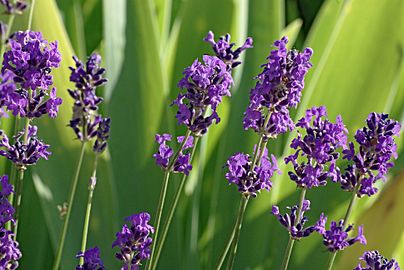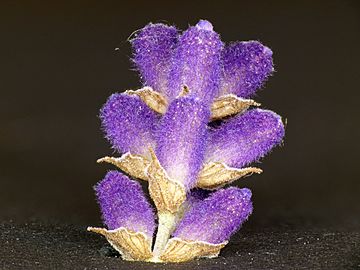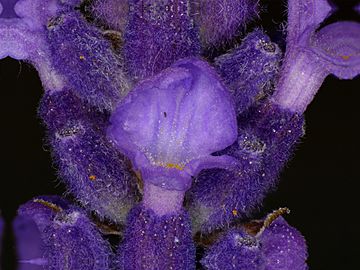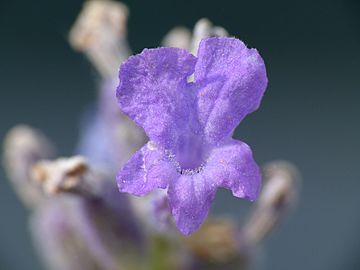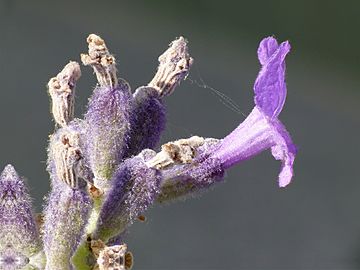Lavandula angustifolia facts for kids
Quick facts for kids Lavandula angustifolia |
|
|---|---|
 |
|
| Common lavender (Lavandula angustifolia) | |
| Scientific classification | |
| Genus: |
Lavandula
|
| Species: |
angustifolia
|
| Synonyms | |
Lavandula angustifolia, often called lavender, is a beautiful flowering plant. It belongs to the Lamiaceae family, which also includes mint. This plant is originally from the Mediterranean region, including countries like Spain, France, Italy, and Croatia.
People know it by many names, such as true lavender and English lavender. Even though it's called "English lavender," it doesn't naturally grow in England! Other names are garden lavender, common lavender, and narrow-leaved lavender.
Contents
What Lavender Looks Like
Lavender is a strongly scented shrub, which is a bushy plant smaller than a tree. It can grow to be about 1 to 2 meters (3 to 6.5 feet) tall.
Its leaves stay green all year round. They are about 2 to 6 centimeters (1 to 2.5 inches) long and 4 to 6 millimeters (about 0.2 inches) wide.
The flowers are a lovely pinkish-purple color, which is often called "lavender-colored." They grow on tall, thin stems that don't have leaves. These flower spikes are about 2 to 8 centimeters (1 to 3 inches) long, and the stems themselves can be 10 to 30 centimeters (4 to 12 inches) long.
Why it's Called Lavender
The second part of the plant's scientific name, angustifolia, comes from Latin. It means "narrow leaf," which describes its thin leaves.
Before, it was known as Lavandula officinalis. The word officinalis refers to its history of being used for medicinal purposes.
Growing Lavender
English lavender is a very popular plant to grow in gardens. People love it for its bright, colorful flowers and its wonderful smell. It's also great because it doesn't need a lot of water to survive.
Lavender doesn't like soil that stays wet all the time. It grows best in places with a Mediterranean climate, like where it naturally comes from. This means it prefers wet winters and dry summers. Adding things like gravel to the soil can help water drain away better.
This plant can handle cold temperatures quite well. It can grow in USDA zone 5, which means it can survive temperatures down to about -20°F (-29°C). While it can grow in slightly acidic soils, it prefers neutral or alkaline soils.
Different Types of Lavender
There are many different types, or cultivars, of L. angustifolia. These are special varieties of the plant that have been grown for certain features, like flower color or size.
Some lavender types have won an award called the Royal Horticultural Society's Award of Garden Merit. This award means they are excellent garden plants.
Here are a few examples of different lavender types:
- Dwarf Cultivars: These are smaller types of lavender.
- 'Hidcote Superior' is a small, bushy plant with fragrant gray-green leaves and deep violet-blue flowers. It likes sunny spots and doesn't need much water.
- 'Munstead' is another dwarf type, about 30 centimeters (12 inches) tall, with pink-purple to lavender-blue flowers. It's named after Munstead Wood, a famous garden in England.
- Semi-Dwarf Cultivars: These are medium-sized lavenders.
- 'Hidcote' is a well-known type, about 40 to 50 centimeters (15 to 20 inches) tall, with silver-gray leaves and deep violet-blue flowers.
- 'Jean Davis' is a pale pink lavender that can grow up to 1 meter (3 feet) tall. It's known for its fruity taste.
- Giant Cultivars: These are the largest types of lavender.
- 'Hidcote Giant' is a very strong-growing plant, reaching 90 to 100 centimeters (36 to 40 inches) tall. It has a lovely strong scent and large, deep lavender-purple flowers on long stems.
- 'Vera' is thought to be the original type of lavender. It grows 75 to 90 centimeters (30 to 36 inches) tall and is harvested for its oil.
How Lavender is Used
Lavender flowers and leaves have many uses!
- Herbal Medicine: People use lavender as a herbal medicine. It can be made into lavender oil or a herbal tea. It's often used to help with things like feeling anxious or having trouble sleeping.
- Cooking: The flowers are also used in cooking. They are a common ingredient in a French herb mix called herbes de Provence, especially in the North American version.
- Relaxation and Beauty: Lavender essential oil is often used in massage therapy to help people relax. You can find lavender in many home products like lotions, eye pillows, and bath oils. Both the dried flowers and the oil are popular ingredients in handmade soap.
- Pest Control: Dried lavender flowers and lavender essential oil are also used to keep away clothing moths. Moths don't like the smell of lavender!
- Fire Safety: In Tasmania, Australia, Lavandula angustifolia is on a list of plants that don't catch fire easily. This means it's a good plant to grow near buildings to help protect them from fires.
Lavender Varieties
Lavender has different types, including:
- Lavandula angustifolia subsp. angustifolia
- Lavandula angustifolia subsp. pyrenaica
Lavender Hybrids
When L. angustifolia mixes with another type of lavender called L. latifolia (spike lavender), they create new plants called Lavandula × intermedia. These mixed plants are known as lavandins. They usually bloom a bit later than the regular English lavenders.
See also
 In Spanish: Lavandula angustifolia para niños
In Spanish: Lavandula angustifolia para niños


